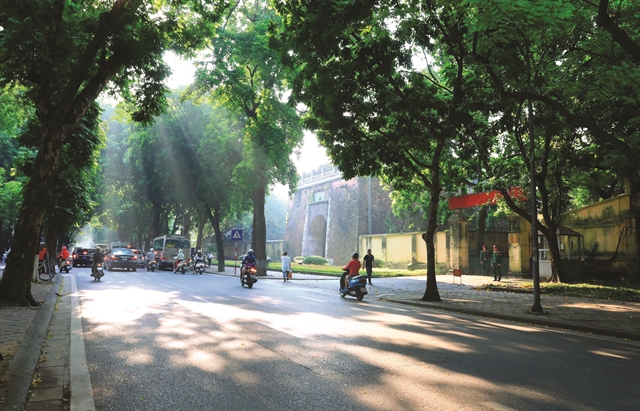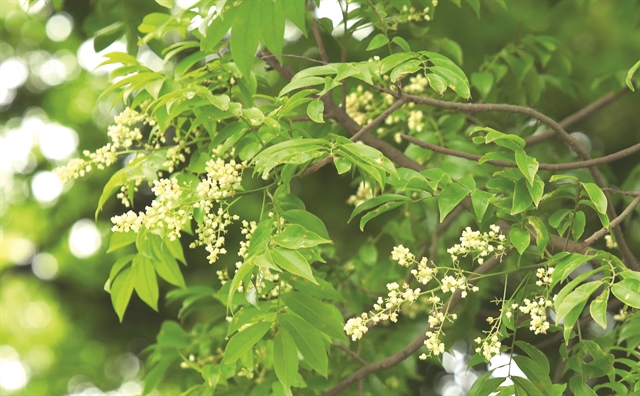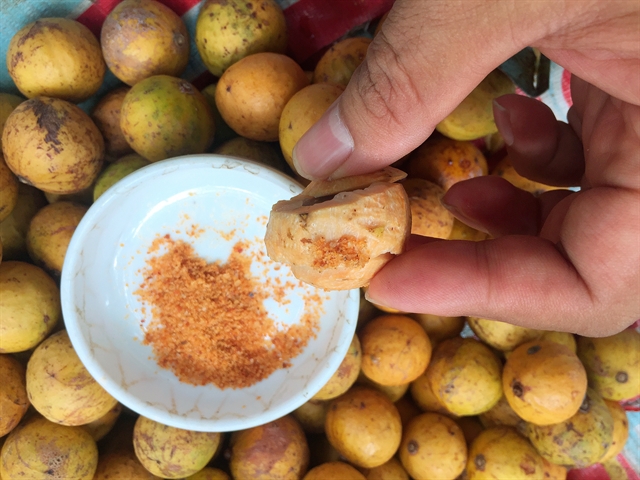[ad_1]
Lê Hương
At the end of August and in early September, when cool winds herald autumn, sấu (dracontomelon duperreanum) leaves fall onto Hà Nội’s streets.
Various streets in downtown Hà Nội like Trần Phú, Phan Đình Phùng and Trần Hưng Đạo host tall old sấu trees.

As well as offering big shadows year-round, sấu trees also provide fruit, which can be boiled in water morning glory vegetables to make a sour soup or processed into a kind of sweet syrup to drink with ice.

Anh Đức from Thạch Thất District on the western outskirts of Hà Nội goes to streets with sấu trees to pick fruits from high branches.
His belongings include a long bamboo stick tied with a basket on one end and a sack to store the fruit.
“When I was small, my dad planted four sấu trees in our garden,” Đức recalled. “He said when you [Đức and his brothers] get old, you will have sấu trees to live on. Among the trees, there is a special genre called sấu đường (sweet dracontomelon), which offers very sweet and fragrant fruits in autumn.”
In harvest season, Đức’s father sold fruits from three of the trees and left the sweet kind for his kids.
“After school, my brothers and I would climb up the tree, bring along a knife to peel off the covers and ate the sweet fruits there on the high branches,” he said.
Đức said the tree offered so many fruits that they brought them to Hà Nội to sell so they could buy clothes and books for the new school year.
Because of his experience from childhood, Đức can climb trees in downtown Hà Nội and pick a full sack of sấu fruits in an afternoon and sell them within an hour.

The green sấu fruit can be boiled with vegetables to make a sour soup which provides vitamin C to cool off the body in summer, while mature sấu fruits can be eaten raw with some salt and chilli or sugar and chilli. The fruits can be mixed with sugar to make a kind of syrup served with ice.
A kilogramme of the yellow mature fruit sells for VNĐ60,000-70,000 (US$2.6-3).

The fruit season comes from June to September.
“I used to study in Phan Đình Phùng High School, which hosted old tall sấu trees,” said student Hà Phương. “In the morning on the way to school, I would walk slowly on the pavement to look for a mature yellow sấu fruit that had fallen down.
“Sometimes, a ripe fruit would fall on my head, onto the pavement,” she said. “I would run after the fruit, wipe it on my shirt and bite. Its taste was so delicious. That’s my beautiful memory of autumn at high school.”
The small ripe yellow fruit contains so many memories for Hanoians.
“I grew up in Hà Nội but have resided in HCM City for few years now,” said Lê Giang. “My parents send green sấu fruits to me in summer. I put them in the fridge to boil with vegetables gradually. In autumn, my mum sends me ripe sấu fruits to make syrup. The yellow sour fruits mingled with chilli and salt taste so good. For me, ripe sấu season marks Hà Nội’s autumn.”

Hanoians consider sấu a delicacy though it’s quite simple and hidden in the green leaves above many streets. — VNS
[ad_2]
Source link
